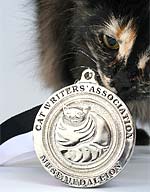 |
|||||||||||||||||||
|
|

We are the proud winners of the 2006 - 2009 winner of the Muse Medallion for Online Magazine by The Cat Writers? Association in their annual Communications Contest! (Photo courtesy of Weems Hutto).
On November 17, 2007 Felinexpress.com was honored to receive The President's Award by the Cat Writers' Association. We are very proud to have earned this distinction and will continue to provide quality information for all cat lovers.
Felinexpress.com home > Cat Care > Kitty Litter - Starting from Scratch |
Kitty Litter - Starting from Scratch
If you have a cat or two sharing your home, you are by now well acquainted with kitty litter; a substance dealt with on a daily basis. You wrestle the bags home, you pour the mixture into your litter pan(s) and then in the following days, you diligently scoop and discard soiled litter, placing new kitty litter in the pan over time.
But what exactly is it made of? Where did it come from? Why does some kitty litter clump and others do not? How many different kinds of kitty litter are there? Is kitty litter really safe?
In 1947 a neighbor asked a gentleman, by the name of Edward Lowe for something to use for her cat’s elimination needs. She explained her husband was upset over the odor and had told her that if she couldn’t find something else (besides ashes and dirt) the cat had to go!
Operating a small business out of his home, Lowe sold clay to garage owners to soak up oil spills. He suggested his clay as an alternate means. The next morning, the neighbor elatedly reported that the clay litter proved wonderful!, Edward decided to gamble on its success. He rented a large semi-trailer and truck, and painted the words “kitty litter” across both sides. Then he began to truck his kitty litter across the United States, stopping at cat shows and trade shows to give away his product. The idea was so well received by grateful cat owners that virtually overnight, from a very simple product, the kitty litter industry was born. In 1991 Edward Lowe sold the rights to the kitty litter filler from his then multi- million multi- national company. The company at the time had over five-hundred employees and netted $165 million in sales yearly.
The Inside Scoop……..
The conventional kitty litter consists of filler made from clay and/or sometimes silica. You may have seen silica before. Silica comes in small envelopes inside new aspirin bottles, shoeboxes and beef jerky. Silica’s purpose; too maintain freshness.
The clay litter comes as Bentonite or Attapulgite/Montmorillonite. Bentonite known also as the “performance mineral,” can be found in a wide variety of products ranging from environmental products to hazardous waste control. Bentonite is dug out of the earth and processed in special manufacturing plants. Bentonite attracts water to its negative face and magnetically holds the water firmly in place. Bentonite can absorb up to 7-10 times its own weight.
Transported to a special facility in large trucks, then loaded into long cylinder rotary dryers, the clay has approximately 15-20% of its moisture removed. The finished product contains a moisture content of between 7-10%. The bentonite then becomes processed into either a fine powder or granulated into small flakes, packaged for commercial use, the mixture becomes something cat owners now utilize; Scoopable Kitty Litter.
If it comes from the earth, then it must be environmentally safe, right? According to the Bureau of Waste Management, approximately 8 billion pounds of kitty litter is dumped into landfills every year! That is over twice the amount of disposable diapers! Also within the clay litter there lays an inherent risk factor. According to the International Agency for Research on Cancer, silicon particles which can be found in clay litter are a known human carcinogen. Breathing in these particles can cause respiratory illness.
When your cat goes to cover her waste, this dust is kicked up and introduced into the room. Distributed on the floor and anywhere else it chooses to settle, the dust becomes an invasive intruder. Research has shown that silicon particles do indeed cause cancer-like symptoms in lab rats, but so far, there is no data available to say if it does the same in cats. Although there exists evidence that silicon particles causes problems in humans, case studies available, only shows that cats with respiratory illnesses have six times the amount of silica in their lungs than healthy cats do. But the studies are greatly overshadowed by the needs of cat owners, and the availability and ease of using clay litter.
Although Green Litters are slowly making their appearance and steadily gaining in popularity, it will take time before they actually corner the market and take away the potential sales that clay litter now holds so firm. Green litters are made out of everything from crushed walnut shells, to compressed sawdust, recycled paper, wheat, pine, alfalfa, and even corn. The Green Movement Group claims their litter is safe, biodegradable, even scoopable and/ or flushable, as well as super absorbent. One company- Tray Tres Chic boasts that not only does their litter weigh less, but you use less, for the litter goes a long way before needing to be replaced.
Plastic trays to hold the litter have made headway into technological advances, and now you have your choice between computerized litter pans that remove the waste after the cat exists the pan, or a litter robot (an ingenious device that rotates and removes the waste material in timed intervals after your cat exits the robot). There are companies that design litter containment furniture, litter air filtration devices, and even a kit where you can train your cat to use your toilet instead of the litter pan.
The litter industry has traveled a long way since 1947 when Edward Lowe displayed his burst of generosity, trucking his product to give it away to all the cat lovers across the United States. Today the Litter Industry rakes in over 700 million dollars a year. It’s a competitive business, but someone has to help make it cleaner, and smell fresher. There are a lot of companies currently chasing this goal. They are finding the needs of cat owners are paramount. If they can come up with the right formula to stop the odor and cut down on the waste, they can become a success in the kitty litter industry today. In other words; they can really clean up.
More cat breeds |
|
? Copyright 2006-2010 Felinexpress.com, All Rights Reserved
Privacy Statement - Disclaimer - About Me


